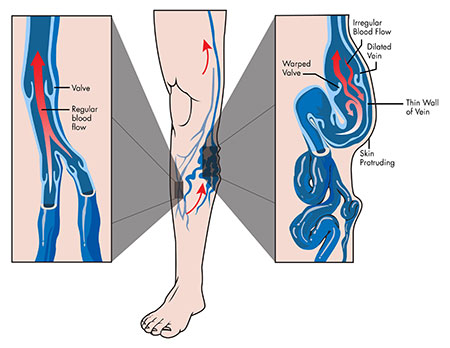[rev_slider alias=”varicous”]

What are Varicose Veins?
Both veins and arteries work to carry blood. Our arteries carry oxygen rich blood from the heart while our veins return blood from our extremities back to our heart. Our veins are equipped with a one-way valve system in order to prevent our blood from flowing in the wrong direction. Failure of these valves results in the back flow and pooling of blood. This failure to function is often referred to as vein reflux and can be noted by the appearance of enlarged, swollen veins, called varicose veins. Varicose veins increase pressure on the fully functioning valves, forcing healthy veins to work harder. As they reduce the effectiveness of blood circulation, varicose veins can be more than just an aesthetic concern.

Varicose veins usually result either from incompetent saphenous veins or incompetent perforator veins that connect the superficial venous system to the deep venous system. These veins tend to be large and can be situated deep beneath the skin’s surface. When several varicose veins are clustered together, the area can be quite tender, causing pain and heaviness.
In general terms, varicose veins refer to the veins on the leg, although they can occur elsewhere on your body including face and hands. They can protrude or appear flat on the surface of the skin.
There are two different venous systems in the leg:
- Deep System– which is responsible for approximately 90% of blood return
- Superficial System– which is responsible for approximately 10% of blood return
Symptoms of Varicose Veins
- Aching, heavy legs (often at the end of the day, or following exercise)
- Appearance of spider veins in the affected leg
- Swelling of the ankle
- Skin discoloration (brownish-blue in color) near the affected veins
- Redness, dryness, and itchiness of the skin in the affected area
- Cramps may develop especially when making sudden movements
- Minor injuries to the area may bleed more than normal
- Minor injuries to the area take a lengthy time to heal
- Restless legs syndrome – a disorder where an individual feels the need to constantly move their leg in order to prevent feelings of discomfort.
- Whitened, irregular scar-like patches can appear at the ankles (atrophie blanche)
Complications of Varicose Veins
Some varicose veins may cause virtually no discomfort, while other can cause extreme cramping, aching, and swelling. These symptoms can be aggravated by various factors, including standing for extended periods of time and menstruation.
In some instances, varicose veins can cause the development of phlebitis or even leg ulcers.
Phlebitis (inflammation of the veins): Often recognized by warm or redness in the area, pain or burning in the vein, vein may also appear and feel hardened.
Leg Ulcers: Leg ulcers appear as wounds caused by the failure of the valves in leg veins to function properly. In individuals with sensitive or thinning skin, eczema or chronic discolouration of the skin may occur. Those individuals, who choose to leave their varicose veins untreated, may also experience pain, fatigue, and swelling of the legs and ankles.
Prevention of Varicose Veins
It is estimated that anywhere from 10-20% of the population will experience some form of varicose veins. While they can be seen in younger individuals, they tend to appear after the age of 30 and often continue to worsen with age.
While the exact cause of varicose veins is difficult to pin point, approximately half of those individuals who experience varicose veins have a family history of the problem.
There are certain factors that can cause the worsening or even the onset of varicose veins:
Heredity: This is the most common cause of varicose and spider veins, though previously healthy veins may become varicose following injury or inflammation
Pregnancy: During pregnancy, there is a vast increase in the amount of blood in the body. This increase can cause veins to enlarge. The increased size of the uterus can also put added pressure on the veins. The amount of varicose veinstends to increase with each successive pregnancy
Sex: Varicose veins are more commonly seen in women
Age: As we age, the valves in our veins may weaken and potentially not function as efficiently
Standing for extended periods of time: The valves in our veins need to work harder to pump blood when we are standing upright
Being Overweight: Carrying excess weight puts extra pressure on your veins.
Causes of Varicose Veins
It is estimated that anywhere from 10-20% of the population will experience some form of varicose veins. While they can be seen in younger individuals, they tend to appear after the age of 30 and often continue to worsen with age.
While the exact cause of varicose veins is difficult to pin point, approximately half of those individuals who experience varicose veins have a family history of the problem.
There are certain factors that can cause the worsening or even the onset of varicose veins:
Heredity: This is the most common cause of varicose and spider veins, though previously healthy veins may become varicose following injury or inflammation
Pregnancy: During pregnancy, there is a vast increase in the amount of blood in the body. This increase can cause veins to enlarge. The increased size of the uterus can also put added pressure on the veins. The amount of varicose veinstends to increase with each successive pregnancy
Sex: Varicose veins are more commonly seen in women
Age: As we age, the valves in our veins may weaken and potentially not function as efficiently
Standing for extended periods of time: The valves in our veins need to work harder to pump blood when we are standing upright
Being Overweight: Carrying excess weight puts extra pressure on your veins.
